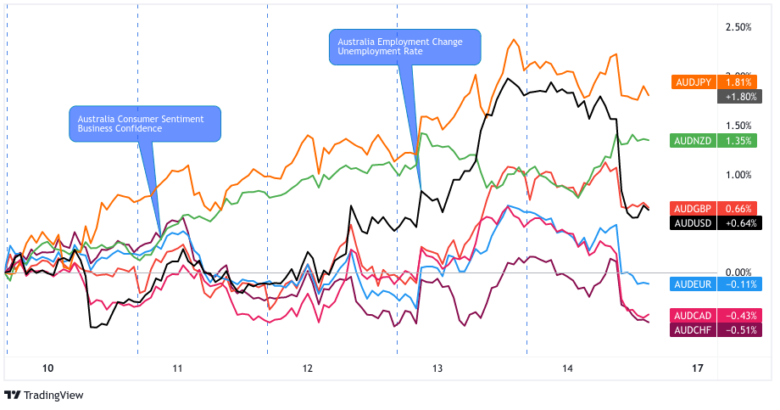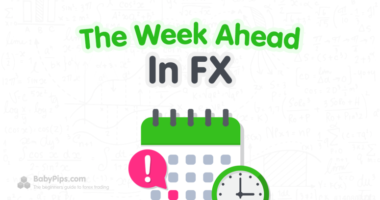Will this week’s Australian jobs numbers support another rate hike for the Reserve Bank of Australia (RBA)?
Here are major points you need to know if you’re planning on trading Australia’s labor market report this week:
Event in Focus:
Australia’s April Employment Data: Employment Change, Unemployment Rate
When Will it Be Released:
May 18, 2023 (Thursday) 1:30 am GMT
Use our Forex Market Hours tool to convert GMT to your local time zone.
Expectations:
- 25,100 net jobs added for the month of April, slower than the 53K jobs added in March
- Unemployment rate to maintain its 3.5% reading (a 50-year low) for a third consecutive month
- Labor force participation rate to remain at 66.7%
Relevant Data Since Last Event/Data Release:
- Judo Bank Australia Services PMI Business Activity Index shot up from 48.6 to 53.7 – its fastest pace in a year – in April
- ANZ job advertisements tumbled 0.3% month-over-month in April, following an earlier 2.4% slump
Previous Releases and Risk Environment Influence on the Australian Dollar
April 13, 2023
Event Results / Price Action:
Australia added a net 64,600 jobs in February, much better than the 49,700 addition expected and January’s net job loss of 10,900.
All the jobs added helped drag the unemployment rate down from 3.7% to 3.5% even as the labor force participation rate ticked higher from 66.5% to 66.6%.
AUD, which was ranging near its U.S. session closing prices, shot up against its major counterparts at the report’s release. In fact, the highs reached in the first hour after the release became key inflection points during the London and U.S. session trading.
Risk Environment and Intermarket behaviors:
Markets were in risk aversion mode a day before the report as traders priced in Credit Suisse admitting to “significant deficiencies” in their financial reporting and Saudi National Bank – Credit Suisse’s largest investor – not providing financial help to the banking giant.
Luckily, the Swiss National Bank (SNB) stepped in a day later and eased banking fears. Australia’s better-than-expected jobs data helped the “risky” AUD sustain a mid-week rally and eventually end the week in the green against all major counterparts but NZD and JPY.
March 16, 2022:
Event Results / Price Action:
Australia added a net of 53,000 jobs in March, more than twice the estimated 20,800 increase and only a little lower than February’s 63,600 gain. The jobless rate held steady at a (near) 50-year low of 3.5%.
AUD, which was ranging near its daily open prices, revisited its U.S. session highs at the news. Price pulled back during the European session, but it ended the day higher against all major counterparts except NZD.
Risk Environment and Intermarket behaviors:
A slower-than-expected U.S. CPI report and the FOMC meeting minutes revealing that members considered a rate hike pause boosted risk appetite just before Australia printed its jobs data.
The risk-friendly trading environment helped AUD beat its counterparts at the report’s release. The move only lasted until the U.S. session, however, as the U.S. PPI report commanded risk sentiment during the U.S. session.
Price action probabilities:
Risk sentiment probabilities:
Risk assets like the Australian dollar are starting the week on shaky ground even as they take advantage of the anti-USD sentiment ahead of Tuesday’s debt ceiling talks.
We could see a clearer picture of risk sentiment intraweek trends after China prints its producer and consumer-related reports (currently expecting rebounds in retail sales & industrial production data). FOMC member speeches – which may lean more hawkish than dovish – could also boost USD and weigh on broad risk-on sentiment.
At the moment, the outlook for broad risk behavior looks to be choppy; likely best to stay nimble, see and react to top tier events.
Australia Dollar scenarios:
Potential Base Scenario:
Based on the last two releases and the Reserve Bank of Australia’s (RBA)’s decisive interest rate hike, it looks like Australia’s labor market may show more strength in April.
But between U.S. debt ceiling concerns, global growth fears, and hawkish FOMC speculations, AUD’s direct reaction to a positive reading may be confined to Asian session trading.
The bulk of AUD’s reaction tends to happen in the first hour after the release. That doesn’t mean we’ll see that again, but it’s probably a good idea to factor this behavioral tendency into your strategy and risk management plan beforehand.
If you missed the initial move, you can also make intraday trades with the post-release highs/lows as inflection points, as long as fresh catalyst doesn’t come along to shift intraday biases.
In case of another better-than-expected release & broad risk sentiment leans positive, consider buying AUD against safe havens like USD, JPY, and CHF.
Potential Alternative Scenario:
If Australia’s headline jobs figures miss market estimates, then expectations of a June rate hike for the RBA may ease and AUD may lose ground.
Consider shorting AUD against USD but also against currencies with hawkish central banks like NZD and GBP; conviction in AUD shorts may grow if broad risk sentiment is leaning negative on the session.










